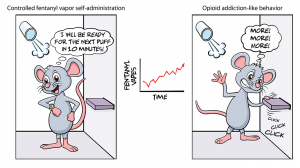 Hot Off the Press – August 27 , 2020.
Hot Off the Press – August 27 , 2020.
This paper describes a new non-invasive model of opioid addiction in mice that is based on fentanyl vapor self-administration. This model allows the study of limited and prolonged drug intake, abstinence, and relapse to drug seeking. Compared to current intravenous models, the new model is more conducive for longer access to drugs and has very low attrition rate. This model enables the investigation of the neurobiology of opioid addiction in unprecedented ways.
Publication Information
Fentanyl vapor self-administration model in mice to study opioid addiction. Journal Article
In: Sci Adv, vol. 6, no. 32, pp. eabc0413, 2020.
